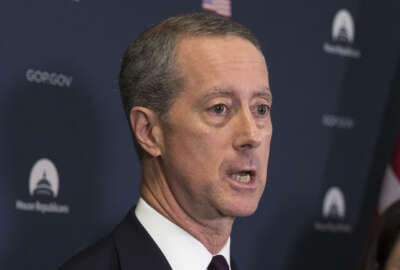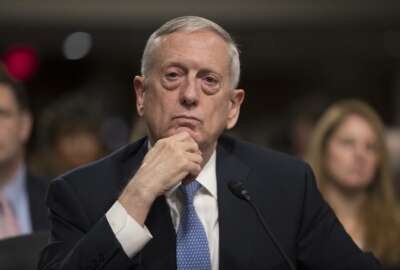
Budget options are aplenty for DoD as funding supplemental deadline nears
The Trump administration needs to work around roadblocks, solidify its plans and use a pinch of skepticism to better the military.
A lot of speculation is going on around Washington concerning how much money the Defense Department will actually receive until the end of the year and into 2018 and where it might go.
Despite President Donald Trump’s promise to beef up the military, many factors are at play, such as the return of sequestration, Congress’ ability to pass spending bills and the demeanor of the new fiscally conservative Office of Management and Budget director.
That’s not to mention the multitude of interests in DoD playing tug of war for money. But there may be some certainties in the budget, especially if you’re used to looking at the budget from the inside out.
Near Term
Defense Secretary James Mattis released a memo earlier this month promising to deliver a 2017 budget supplemental to Congress by March 1.
Former DoD Comptroller and Booz Allen Hamilton Fellow Bob Hale said he expects that budget to weigh somewhere in the “tens of billions” of dollars, during a Feb. 21 speech at the Brookings Institution in Washington.
“In terms of priorities I would expect they’ll follow some of what Secretary Mattis and President Trump have said. Mattis has said Russia is the biggest threat to U.S. security. I would expect we would see support for things like European Reassurance Initiative, which helps counterdeployments in Eastern Europe. President Trump has said ‘ISIS, ISIS, ISIS,’ so I assume we will see some continual emphasis on special operation forces,” Hale said.
The Obama administration requested $3.4 billion for the European Reassurance Initiative in the 2017 budget. That fund only has about $800 million in it right now because DoD is working on a continuing resolution, tied to the amount of funding Congress appropriated for it in 2016.
Hale said readiness is another issue DoD seems interested in addressing in the short term. Things like increasing pilot training hours might see some funding in the budget supplemental.
Outside of directly operational programs, Hale said he’s hoping the amendment will fund modernization needs in the services, especially since traditionally buying for the future tends to fall by the wayside in fiscally tough times.
“Procurement hasn’t fared well. It is almost always the way the Pentagon reacts to downturns in the budget and it happened again this time, so we do need some increases in procurement and I would home we would see some of that in the amendment,” Hale said.
House Armed Services Committee Chairman Mac Thornberry (R-Texas) put his chips on DoD requesting money for modernization and buying in the military forces for the amendment. The final 2017 defense authorization act scrapped about $15 billion his committee authorized for DoD.
“The place where I have suggested the administration start [with the supplemental] is look at the items that were in the House passed NDAA last year and that ultimately did not make it into the final conference report that was signed into law,” Thornberry said on Feb. 6. “I think in my view they ought to be at the top of the list, especially some modernization items.”
Thornberry said the supplemental is needed to turn the corner on the readiness.
The House bill called for 10 carrier wings, instead of the nine President Barack Obama requested. It would have procured 15 F-18s instead of two, 72 Blackhawk helicopters instead of 36 and 74 F-35s instead of 63.
The bill called for other aircraft procurements and a larger Navy, increasing Littoral Combat Ships to three and Virginia Class Submarines by one.
The bill also increased funding for the Missile Defense Agency and the National Nuclear Security Agency.
Hale said DoD needs to be careful in how much it requests, however.
“They’ve got to be careful in the budget amendment because they’re going to get this approved maybe with five months left in the fiscal year and that money we are talking about has to be obligated by the end of the fiscal year, so I think they’ll have to be modest there,” Hale said.
The bump in the road
Part of passing the amendment and funding the military past 2017 involves working around sequestration, which puts caps on how much can be spent each year.
Passing a budget amendment for 2017 and appropriating the requested money would trigger sequestration and without another budget deal the Budget Control Act (BCA) goes back into effect in 2018.
“There’s several ways they can handle this. One way is to flatly repeal at least the defense portions of it or worse yet in my view declare all the money in the 2017 budget amendment emergency funding and therefore not subject to the BCA,” Hale said. “I hope they don’t do that, it would essentially increase the deficit, which remains substantial and we are at nearly full employment in this nation if we are thinking of balancing the budget over a business cycle we probably ought to be running surpluses now.”
Declaring the amendment an emergency fund would treat it like the overseas contingency operations fund (OCO), a kitty originally made to fund war measures. OCO has recently been treated more like a slush fund for Congress and DoD to circumvent sequestration and still pay for important long term items. Critics say using OCO for that purpose is irresponsible and doesn’t allow the department to plan ahead.
A second way to deal with the BCA is to change it so defense can be increased while nondefense will be decreased, basically keeping the amount of money in the BCA the same but changing the weights on the scale.
“The problem there is many of the agencies in the nondefense area contribute in significant ways to national security. Think the [Veterans Affairs Department], think the Department of Homeland Security, think about the State Department, the FBI, about half of the Department of Energy is the National Nuclear Security Administration, which maintains the nuclear stockpile,” Hale said. “Big cuts in nondefense, even leaving aside the other nondefense issues the nation faces, would have adverse effects on national security.”
Hale said he hopes Congress will pass a budget deal that considers entitlements and also adds revenues through taxes, fees or closing loopholes.
The long run
President Trump said during the campaign he wants to increase the size of the military and that’s certainly going to cost more money, especially in the out-years.
That has to be balanced with the military services plea for more readiness funds. But Hale warned the readiness crisis may not be as bad as the services imply.
“We’ve heard strong concern expressed recently by the service on readiness. You need to be a little skeptical. There’s money available right now. I’ve often said it’s harder in the Pentagon to give out money than it is to cut it and there’s some truth to that. This is a time when the services, if you will, want to put their worst foot forward and make clear all the problems there are there. So, I think we have to be a little skeptical. That said, there are readiness problems there,” Hale said.
He noted the Obama administration regularly asked for about $30 billion more in defense money than Congress appropriated to fix readiness.
Mattis said in his Feb. 1 memo DoD will focus its 2018 budget on “growing the force structure to the maximum responsible rate.”
The 2018 budget will address pressing programmatic shortfalls and rebuild readiness. That includes building programs for advanced capabilities as well as buying critical munitions and funding facilities sustainment at a higher level.
Hale said if DoD can get more money from Congress in the road ahead it should focus on infrastructure and non-major procurement like munitions and spare parts.
Those areas have taken big hits in the past, some military facilities are on refresh cycles as long at 100 years.
Copyright © 2025 Federal News Network. All rights reserved. This website is not intended for users located within the European Economic Area.
Scott Maucione is a defense reporter for Federal News Network and reports on human capital, workforce and the Defense Department at-large.
Follow @smaucioneWFED




